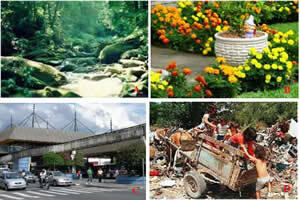Air Pollution or Atmospheric Pollution is the result of the release into the atmosphere of large quantities of liquid and solid gases or particles, which cause environmental impact and human health.
Among the polluting substances we have industrial dust, aerosols, black smoke, solvents, acids and hydrocarbons.
In several countries, the level of air pollution is above what is considered acceptable by the WHO (World Health Organization).
Although China is often remembered as one of these countries, many efforts are being made to reverse this serious situation.
In the list of countries that release the greatest amount of carbon dioxide, Brazil appears in the first places.

Air pollution: a common landscape in many countries
Causes
Air pollution can be caused by natural sources or by human activities.
natural sources
 Volcanic activity releases polluting gases
Volcanic activity releases polluting gases
Some natural processes are responsible for the release of polluting gases into the atmosphere:
- Volcano activity
- Release of methane by animals during the digestion process
- desert dust
- Decomposition
human activities
 Cars can release large amounts of polluting gases
Cars can release large amounts of polluting gases
Human or anthropogenic activities also release large amounts of toxic and pollutant gases:
- Industrialization
- burns
- Vehicles and burning of fossil fuels
- Mining
- Use of aerosols
- Electricity production
Main Pollutants
Among the main pollutants that cause imbalances in atmospheric air are:
- Carbon monoxide: Product resulting from incomplete combustion of fuels.
- Sulfur Dioxide and Nitrogen Oxides: combustion products of sulfur present in fossil fuels.
- Carbon dioxide: Product resulting from the burning of any organic matter. It is found naturally in the atmosphere, but when released in large quantities, it causes imbalances, including the greenhouse effect.
- Lead: Product used in gasoline to increase its octane rating. In Brazil, lead was replaced by anhydrous ethyl alcohol as an additive to gasoline for the same purpose.
- Ozone: Ozone gas has different functions depending on where it is found. When found in the troposphere, it causes pollution and acid rain, being harmful to plants and human health.
- Chlorofluorocarbons: These gases are responsible for destroying the ozone layer.
- particulate material: Result of burning fossil fuels such as soot. These materials are extremely polluting.
Consequences
The consequences of air pollution compromise the quality of the environment and people's health.
Environmental problems
Air pollution can affect cultural heritage as a result of acid rain. They gradually corrode monuments.
Another effect is under the ozone layer. Naturally, this layer protects the planet from harmful ultraviolet radiation to living beings.
However, polluting gases form holes in the ozone layer and prevent the sun's rays from being, in part, absorbed.
Furthermore, the increase in polluting gases in the atmosphere intensifies the greenhouse effect and gives rise to global warming.
Also read about Environmental problems.
Illnesses
 In some cities it is essential to wear masks to protect yourself from air pollution
In some cities it is essential to wear masks to protect yourself from air pollution
In addition to environmental problems, air pollution also causes health problems.
Air pollution is one of the most serious problems in cities. Pollutants cause irritation in people's eyes and throats, especially in large cities and megalopolises.
As a result, its effects on human beings are numerous and serious.
In the breathing process, the binding of carbon monoxide and hemoglobin reduces oxygenation to the brain and cells.
In small concentrations it can cause headaches, dizziness, sensory disturbances, among other problems. In high doses, it can lead to death from suffocation.
Sulfur dioxide and nitrogen oxides cause or aggravate respiratory problems such as: asthma, chronic bronchitis, pneumonia and pulmonary edema.
Lead causes nervous disorders, especially in children. In addition to anemia, it hinders the synthesis of hemoglobin in the blood.
Discover other types of pollution:
- Water pollution
- thermal pollution
- Ground pollution
- Visual pollution
- Noise pollution
- radioactive pollution
- light pollution

